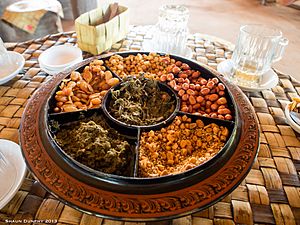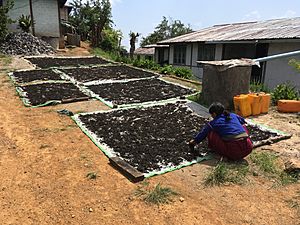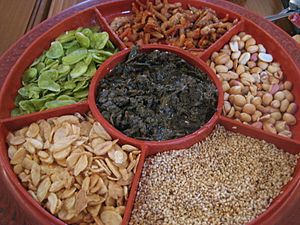Lahpet facts for kids

Lahpet thoke, Burmese tea leaf salad or pickled tea salad is a favourite national dish.
|
|
| Place of origin | Burma |
|---|---|
| Associated national cuisine | Burmese cuisine |
| Main ingredients |
|
Lahpet, also called laphat or letpet, is a special kind of fermented or pickled tea from Myanmar. Myanmar is one of the few countries where people not only drink tea, but also eat it! This makes pickled tea very unique to this region.
Lahpet is a national treat in Myanmar. It's a big part of Burmese society and a traditional way to welcome guests. When you visit a home, you'll often be offered Lahpet. There's a popular saying that shows how important it is: "Of all the fruit, the mango's the best; of all the meat, pork's the best; and of all the leaves, lahpet's the best." In other parts of the world, you might know Lahpet best as "tea leaf salad" (လက်ဖက်သုပ်).
Contents
Different Kinds of Burmese Tea
Burmese tea comes in three main forms:
- Lahpet chauk (လက်ဖက်ခြောက်): These are dried tea leaves. People use them to make green tea, which is called yei-nway gyan (plain hot water) or lahpet-yei gyan (plain tea). Green tea is the most popular drink in Myanmar, especially since most people there follow Buddhism.
- Acho gyauk (အချိုခြောက်): This means "sweet and dry" and refers to black tea. It's used to make sweet tea (လက်ဖက်ရည်ချို) by adding milk and sugar.
- Lahpet so (လက်ဖက်စို): This means "wet tea" and specifically refers to the pickled tea that Lahpet is famous for.
How Good Is the Tea?
Burmese tea is sorted into seven different quality levels:
- 'Golden bracelet' (ရွှေလက်ကောက်)
- 'Extraordinary weft' (အထူးရှယ်)
- 'Weft' (ရှယ်)
- 'Top grade' (ထိပ်စ)
- 'Medium top grade' (အလတ်ထိပ်စ)
- 'Medium grade' (အလတ်စ)
- 'Low grade' (အောက်စ)
-
Lahpet thoke and gyin thoke (ginger salad)
The Story of Lahpet
People in Myanmar have been eating tea for a very long time, even before recorded history! Ancient tribes would pickle tea leaves in bamboo tubes, baskets, or pots. This long history is why the Burmese word for "tea" is different from the Chinese word, which most other languages use. Europeans visiting Myanmar were surprised by how much people loved pickled tea. They even saw people burying boiled tea leaves in holes lined with plantain leaves to ferment them.
According to old stories, tea came to Myanmar in the 1100s during the Pagan dynasty, brought by King Alaungsithu. Records show that people in the royal court drank tea and had special tea servers. As more people in Burmese kingdoms became Theravada Buddhists, pickled tea started to be used in ceremonies instead of alcohol. To meet the growing demand, tea farms spread across the northern Shan States after 1500.
By the late 1700s, tea became an important product that Burma sold to other countries. The Mandalay Palace even had a special Tea Pavilion where young helpers prepared tea. A famous Burmese poet, U Ponnya, wrote poems about Lahpet, saying it was a favorite of the royal court and a key part of royal meals.
In ancient Myanmar, Lahpet was a symbol of peace. When kingdoms had a disagreement, they would exchange and eat Lahpet after they settled their dispute. In both old and colonial times, Lahpet was served after a judge made a decision in court. Eating the Lahpet meant you accepted the judge's decision.
Where Tea Grows
Tea plants grow naturally in Myanmar. Two common types of tea plants, Camellia sinensis and Camellia assamica, are grown in the northern Shan State, especially around Namhsan. Tea also grows near Mogok in the Mandalay Region and Kengtung in eastern Shan State.
The "Zayan" leaves, which make up about 80% of the tea harvest, are picked in April and May, before the rainy season starts. However, tea can be picked until October. Over 700 square kilometers (about 270 square miles) of land in Myanmar are used for growing tea. Each year, these farms produce 60,000 to 70,000 tons of fresh tea leaves.
Of this harvest, about 69.5% becomes green tea, 19.5% becomes black tea, and 20% becomes pickled tea. When we look at how much tea the country uses each year, 52% is green tea, 31% is black tea, and 17% is pickled tea.
How Lahpet Is Made
Making traditional Lahpet involves three steps: pre-fermentation, fermentation, and then preparing the fermented leaves. Only the soft, young tea leaves and buds are chosen for fermenting. The other leaves are dried. After picking, the tea leaves are steamed for about five minutes. Then, the young leaves are packed into bamboo containers or clay pots. These pots are placed in pits and pressed down with heavy weights to squeeze out water.
The fermentation process is checked regularly. Sometimes, the tea pulp needs to be steamed again. Natural bacteria help the tea ferment without air, and this process takes about 3 to 4 months. You can tell the tea is fermenting by its color changing from green to golden-green, its texture becoming softer, and its sourness decreasing over time. Finally, the almost-ready tea pulp is washed, massaged, and drained. To finish, Lahpet is flavored with chopped garlic, ground chili, salt, lemon juice, and peanut oil.
Ways to Enjoy Lahpet
Burmese Lahpet (လက်ဖက်သုပ်) is served in two main ways. The first way is mostly for special events and is called A-hlu lahpet (အလှူလက်ဖက်). The second way is more common and is usually eaten with meals.
A-hlu lahpet is traditionally served in a special lacquerware dish with a lid and many small sections, called a lahpet ohk. The pickled tea, flavored with sesame oil, goes in the middle section. The other sections hold ingredients like crispy fried garlic, chickpeas, toasted sesame seeds, peanuts, dried shrimp, preserved shredded ginger, and fried shredded coconut.
This type of Lahpet is served at Buddhist ceremonies, like when young boys become monks (called shinbyu), and at weddings. No special event in Myanmar is complete without A-hlu lahpet. It's also offered to nature spirits. In the past, invitations to a shinbyu ceremony were given by going door-to-door with a lahpet ohk. If you took some Lahpet, it meant you accepted the invitation.
Lahpet can be a snack or served after a meal for family and guests. It's usually placed in the middle of the table with green tea. It has a mix of bittersweet and strong flavors, and a leafy texture. Many people believe it helps with digestion and has other health benefits. Its caffeine gives you energy, which is why it's popular with students studying for exams, people watching all-night shows, and those staying awake at funerals.
Lahpet thohk (လက်ဖက်သုပ်) is a pickled tea salad that is very popular across Myanmar, especially with women. It's made by mixing the ingredients from A-hlu lahpet (but usually without coconut) and adding fresh tomatoes, garlic, green chilis, and shredded cabbage. It's dressed with fish sauce, sesame or peanut oil, and lime juice. Eating Lahpet with plain white rice is another favorite for students and is often served at the end of meals.
Some popular brands of Lahpet you can buy include Ayee Taung lahpet from Mandalay, Shwe Toak from Mogok, and Yuzana and Pinpyo Ywetnu from Yangon. You can also find ready-mixed ingredients like fried garlic, peas, peanuts, and sesame, which are called Hna-pyan gyaw (twice-fried) for convenience. Ayee Taung has been around for over 100 years and has new popular recipes like Shu-shè (extra hot) and Kyetcheini (Red Cross).
Zayan lahpet is Lahpet mixed with carambola (star fruit) and young tea leaves. Many people prefer Mogok lahpet because it uses only young tea leaves.
In northern Thailand, in places like Chiang Mai, you can find lahpet thohk at restaurants that serve Shan ethnic food. In Thai, it's called yam miang.
The town of Pyay is known for a local treat called taw laphet (တောလက်ဖက်), or "rural Lahpet." This Lahpet is made from the leaves of the naywe tree. The tea pulp is tightly wrapped in dried banbwe leaves and soaked in water that is changed regularly for up to two years before it's eaten. Taw laphet is eaten in the same way as traditional Lahpet.
See also
 In Spanish: Lahpet para niños
In Spanish: Lahpet para niños










